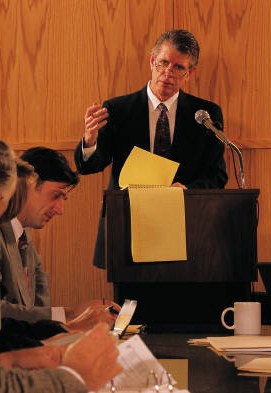In Mr. Smith Goes to Washington, the naïve Mr. Smith yields the Senate floor out of courtesy to a colleague, In doing so he loses his ability to debate on his legislation to prevent graft and corruption, Mr. Smith learned the hard way about the importance of knowing procedural rules. Officers and members of boards and and associations need to know the rules of order to achieve their goals and help their enterprises succeed. Our expertise includes:
- Meeting and Session Governance Services
- Presiding Officer Services
- Delegate Convention or Assembly Services
- Strategic Procedural Planning Services
- Bylaw Drafting, Review, and Revision Services
- Written Opinions Services
- Training Programs
What are we voting on? Which question comes first? These questions often arise in meetings, and the answer relies in part on what’s called the order of precedence or the rank of a motion. Motions have a rank order of precedence. That is, the motion with the highest rank is the motion that is under consideration. If a motion is made of a higher rank than the one currently pending, then the higher-ranked motion has precedence, and must be decided on before returning to the lower ranked motion. Also a lower ranked motion cannot be made while a motion of higher rank is pending.
Only 13 motions in Robert’s Rules have a specific rank. The Table of Motion Rankings shows these motions and their rank with the main motion being the lowest ranked and the motion to fix the time to which to adjourn as being the highest ranked motion. At any given time, one or more of these motions may have been made, but only the highest ranked motion can be addressed at any given moment.
Table of Motion Rankings
Rank Motion
Motion
1. Fix the time to which to adjourn
Fix the time to which to adjourn
2. Adjourn
Adjourn
3. Recess
Recess
4. Raise a question of privilege
Raise a question of privilege
5. Call for the orders of the day
Call for the orders of the day
6. Lay on the table
Lay on the table
7. Previous question
Previous question
8. Limit or extend limits on debate
Limit or extend limits on debate
9. Postpone to time certain
Postpone to time certain
10. Refer or commit to committee
11. Amend
12. Postpone indefinitely
13. Main Motion
Here’s how it works. A member of an assembly makes a main motion to purchase five computers. Another member makes a motion to amend by adding “at a cost not to exceed $5,000.” Because the motion to amend ranks higher than the main motion, it must be decided first. Furthermore, the motion to postpone indefinitely could not be made until the amendment has been decided because it has a lower rank.
But let’s say that during debate, someone believes that more information is needed, and he or she moves to commit the motion to a committee for further study and that the committee must report back by the next meeting. Since the motion to commit has a higher rank than the motion to amend, it must be decided before the motion to amend or the main motion. If someone then makes a motion to postpone to the next meeting, then the motion to postpone must be decided before any of the others.
The confusing part is unstacking the motions. But it’s rather simple. Think of it as a stack of blocks. You decide on the highest ranked motion first, the block at the top of the stack, and continue to unstack the blocks, decide on motions, until you get to the bottom. The only trick is remembering which block is currently on top or being decided. A good chairman will constantly remind members of an assembly which motion is current under consideration.
In this way questions can be answered in the most efficient and least time consuming manner. Unfortunately that doesn’t always translate into quick decisions or short meetings. It does, however, get you through the meeting as quickly as possible!

© 2011-2013 Call to Order Parlimentarian Service
Which question comes first? Motion ranks and order of precedence.


